Forceps Removal of the Retinal Internal Limiting Membrane in Surgery for Macular Hole and Macular Pucker
A video script for Key Hole & Apple Peel Surgical Removal of ILM
Retina Specialists of Alabama
Apple Peel and Keyhole Videotape awarded American Academy of Ophthalmology Annual Meeting
“Best of Show” in Educational Category (Dallas, Texas / October 22-25, 2000)
Robert Morris, M.D., C. Douglas Witherspoon, MD, Ferenc Kuhn, MD, Ph.D.
Terry J. Moore, MD, S. Wayne Taylor, MD, Suzanne Nelson, R.N.
Helen Keller Foundation for Research and Education- Birmingham, Alabama, USA
See below for Figures and Bibliography.
Abstract
Removal of the internal limiting membrane/epimacular proliferation (ILM/EMP) complex is now a proven method for successful closure of macular holes, and an evolving part of macular pucker surgery. We present new techniques for forceps ILM removal in these conditions.
Macular Holes
In 1997 we introduced a technique we called ILM maculorhexis for treatment of macular holes to minimize foveal traction. This video presents two new versions of ILM maculorhexis – the Key Hole technique and the Apple Peel technique.
Following complete vitrectomy and indocyanine green staining of the ILM as described by Kim and Clark for clear demonstration of the internal limiting membrane, the desired technique is begun.
The stages in performing Key Hole ILM removal are as follows:
- Establish the surgical plane by production of an initial ILM handle using the Morris/Witherspoon ILM forceps.
- Expand the surgical plane by creation of a vertical ILM strip from the arcade vessels to the macular hole. (Figures 1a, b, c)
- Parafoveal ILM maculorhexis. (Figures 2a, b, c)
- Peripheral ILM maculorhexis. (Figures 3a, b, c)
The elastic neurosensory retina is now free of the rigid internal limiting membrane/EMP complex, promoting true and permanent macular hole closure. (See figure 4 at top)
The Apple Peel technique produces a single long strip of removed ILM, eliminating multiple forceps re-insertion steps otherwise required to remove ILM fragments from the eye.
Again using the Morris/Witherspoon ILM forceps, the internal limiting membrane is grasped in a parafoveal location and removed.
A parafoveal ILM maculorhexis is performed, intentionally evolving into subsequent rhexis maneuvers of enlarging diameters.
Finally, the macula is freed of all surface traction, producing a continuous ILM strip for removal from the eye as a single specimen.
Macular Pucker
After complete vitrectomy and careful injection of indocyanine green dye, followed by its removal, the epimacular proliferation complex is gently peeled from the macula in the traditional manner.
ICG dye is then re-injected and removed. Finally, the remaining distorted internal limiting membrane is removed as a second layer, completely freeing the neurosensory macula from all tangential traction.
Acknowledgment:
The Authors are affiliated with
The Helen Keller Foundation for Research and Education and
The University of Alabama at Birmingham
Department of Ophthalmology
Lanning Kline, MD, Chairman
Research Support:
HealthSouth Corporation
Birmingham, Alabama, USA
Figures
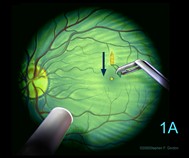 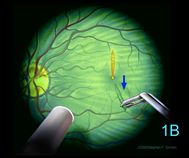 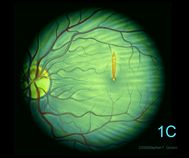 |
FIGURES 1a, b, c
Expand the surgical plane by creation of a vertical ILM strip from the arcade vessels to the macular hole. |
 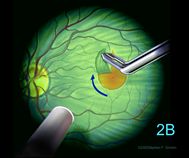 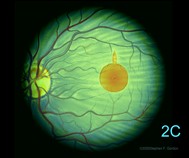 |
FIGURES 2a, b, c
Parafoveal ILM maculorhexis. |
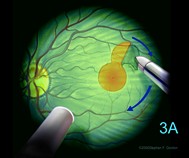 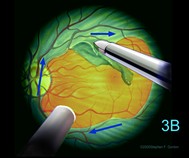  |
FIGURES 3a, b, c
Peripheral ILM maculorhexis. |
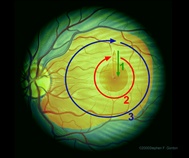 |
FIGURE 4
The elastic neurosensory retina is free of the rigid internal limiting membrane/EMP complex, promoting true and permanent macular hole closure. |
Bibliography
- Vitrectomy in Terson’s Syndrome: A report of 21 cases. Morris, R., Kuhn, F., Brown, S., Feist, R: Scientific paper 1990 American Academy of Ophthalmology.
- Hemorrhagic Macular Cysts. Morris, R., Kuhn, F., Witherspoon, C.D. Ophthalmology 1994:100:1.
- Hemorrhagic Macular Cysts in Terson’s Syndrome and its implications for Macular Surgery. Morris, R., Kuhn, F., Witherspoon, C.D, Mester, V., Dooner, J. In Wiedeman, P, Kohn, L (eds): Macular and Retinal Diseases. Dev. Ophthalmol. Basel, Karger, 1997, vol. 29, pp. 44-54.
- Internal Limiting Membrane (ILM) Maculorhexis for Traction Maculopathy. Morris, R., Witherspoon, C., Kuhn, F., Priester, B. VRST Vol 8 No. 4, Winter 1997.
- Macular Hole: Membrane Dissection Techniques. Witherspoon, C., Morris, R. Kuhn, F., Nelson, S. 1999 Pre-Academy Retina Meeting.
- Traction Maculopathy – Vitreomacular Traction Syndrome, Cellophane Maculopathy, Macular Pucker, Macular Hole. Morris, R., Witherspoon, C., Kuhn, F., Nelson, S., Priester, B., Mayne, R. In Retinology Today, In Memoriam of Klaus Heimann, Krieglstein (eds). Chapter 17, pp. 83-88, April 2000.
|
|
|